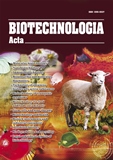ISSN 2410-7751 (Print)
ISSN 2410-776X (Online)

Biotechnologia Acta Т. 17, No. 2 , 2024
P. 38-40, Bibliography 9, Engl.
UDC::612.8: 577
DOI:https://doi.org/10.15407/biotech17.02.038
PREVENTION OF MERCURY-INDUCED EXCITOTOXICITY IN PRESYNAPTIC BRAIN NERVE TERMINALS WITH CARBON DOTS
M.Driuk, N. Krisanova, N. Pozdnyakova, M. Dudarenko, A. Pastukhov, T. Borisova
Palladin Institute of Biochemistry of the National Academy of Sciences of Ukraine, Kyiv
Aim. Xenobiotic metal mercury is one of the major crucial pollutants of global public health concerns according to the World Health Organization assessment. Carbon-containing nanoparticles (CNPs) are promising in nanotechnology. CNPs were obtained by the combustion of citric acid and urea.
Methods. The cortex nerve terminals isolated from Wistar rats were used in the experiments. [14C]glutamate uptake and release in the nerve terminals were monitored using a radiolabeled assay.
Results. It was shown that HgCl2 starting from 5 µM caused a concentration-dependent increase in the extracellular L-[14C]glutamate level in nerve terminals resulted from weak functioning of glutamate transporter, and so significantly decreased L-[14C] glutamate uptake. Combined effects of Hg2+ and CNPs obtained by heating of citric acid and urea were analysed. CNPs were able to mitigate in an acute manner excitotoxic Hg2+-induced increase in the extracellular L-[14C]glutamate level in nerve terminals by 37%, thereby being a provisional Hg2+ scavenger.
Conclusion. Besides biotechnological implementation of data, developed approach can be applicable for monitoring capability of different particles and compounds to mitigate Hg2+ -mediated threat.
Key words: mercury, glutamate, neurotoxicity, nerve terminals, synaptosomes, carbon nanoparticles.
REFERENCES
1. Bridges C.C., Zalups R.K Transport of Inorganic Mercury and Methylmercury in Target
Tissues and Organs. J Toxicol Environ Heal Part B 2010 13:385–410. https://doi.
org/10.1080/10937401003673750
2. WHO Mercury and health. 2017. Accessed 23 Oct 2020https://www.who.int/news-room/factsheets/
detail/mercury-and-health.
3. Diamond G.L, Bradham K.D., Brattin W.J., Burgess M., Griffin S., Hawkins C.A. Predicting oral
relative bioavailability of arsenic in soil from in vitro bioaccessibility. J Toxicol Environ Heal —
Part A. 2016, 79:165–173. https://doi.org/10.1080/15287394.2015.1134038
4. Tagne-Fotso R, Leroyer A, Howsam M, Dehon b., Richeval c. Current sources of lead exposure and
their relative contributions to the blood lead levels in the general adult population of Northern
France: The IMEPOGE Study, 2008-2010. J Toxicol Environ Heal — Part A. 2016 79:245–265.
https://doi.org/10.1080/15287394.2016.1149131
5. Bradham K.D,, Green W., Hayes H. Estimating relative bioavailability of soil lead in the mouse. J Toxicol
Environ Heal — Part A. 2016, 79:1179–1182. https://doi.org/10.1080/15287394.2016.1221789
6. Chizhik AM.AI., Stein S., Dekaliuk M.O,, Battle C., Li W. Huss A., Platen M., Schaap I.A.T., GregoI.,
Demchenko A.P., Schmidt C.F., Enderlein J., Chizhik A.I. Super-Resolution Optical Fluctuation
Bio-Imaging with Dual-Color Carbon Nanodots. Nano Lett. 2016, 16:237–242. https://doi.
org/10.1021/acs.nanolett.5b03609
7. B orisova T.A., Himmelreich N.H. Centrifuge-induced hypergravity: [3H]GABA and L-[ 14C]glutamate
uptake, exocytosis and efflux mediated by high-affinity, sodium-dependent transporters. Adv Sp
Res 2005, 36:1340–1345. https://doi.org/10.1016/j.asr.2005.10.007
8. Soldatkin O., Nazarova A., Krisanova N., Borуsov A., Kucherenko D., Kucherenko I., Kucherenko N.,
Soldatkin A., Soldatkin T. Monitoring of the velocity of high-affinity glutamate uptake by isolated
brain nerve terminals using amperometric glutamate biosensor. Talanta 2015, 135:67–74. https://
doi.org/10.1016/j.talanta.2014.12.031
9. Pozdnyakova N., Pastukhov A., Dudarenko M., Galkin M., Borysov A., Borysova T. Neuroactivity
of detonation nanodiamonds: dose-dependent changes in transporter-mediated uptake and ambient
level of excitatory/inhibitory neurotransmitters in brain nerve terminals. J Nanobiotechnology
2016, 14:25. https://doi.org/10.1186/s12951-016-0176-y
© Palladin Institute of Biochemistry of National Academy of Sciences of Ukraine, 2024

